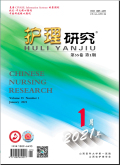护理研究2024,Vol.38Issue(19):3385-3392,8.DOI:10.12102/j.issn.1009-6493.2024.19.001
轴线与非轴线翻身操作对重症高血压脑出血术后病人颅内压及脑灌注压的影响
Influence of axial and non-axial turning over on intracranial pressure and cerebral perfusion pressure in patients with severe hypertensive cerebral hemorrhage after operation
摘要
Abstract
Objective:To explore the impact of axial and non-axial turning methods on ICP and CPP in postoperative patients with severe hypertensive cerebral hemorrhage.Methods:Patients with hypertensive cerebral hemorrhage who met the inclusion and exclusion criteria and had ICP monitoring in the neurosurgical ICU of a tertiary hospital in Tangshan from June 2022 to April 2023 were selected as study subjects.A self-controlled before-and-after study design was adopted.The subjects underwent non-axial and axial turning operations between 21:00-24:00 on the fifth day post-operation when their vital signs were stable.ICP,MAP,and CPP average values were recorded before,during,and at 1 minute,5 minutes,10 minutes,15 minutes,20 minutes,and 30 minutes after each turning operation.The changes in ICP,MAP,and CPP in postoperative patients with severe hypertensive cerebral hemorrhage were compared between the two turning methods.Results:For the non-axial turning method,there were statistically significant differences in ICP,MAP,and CPP before and during the operation(P<0.05).There were also statistically significant differences in ICP and MAP before and at 1 minute and 5 minutes after the operation(P<0.05).For the axial turning method,there were statistically significant differences in ICP and MAP before and during the operation,and at 1 minute after the operation(P<0.05).There was a statistically significant difference in CPP before and at 1 minute after the operation(P<0.05).When comparing the amplitude of ICP changes between the two turning methods,statistically significant differences were observed in the amplitude of change between during the operation and before the operation,and between 5 minutes and 1 minute after the operation(P<0.05).Conclusion:Both turning methods caused significant changes in ICP,MAP,and CPP in postoperative patients with severe hypertensive cerebral hemorrhage.The rise in ICP is lower with axial turning than with non-axial turning,and the decrease in CPP is more pronounced with non-axial turning,indicating that axial turning is safer than non-axial turning for nursing care of postoperative patients with severe hypertensive cerebral hemorrhage in neurosurgery.This provides a practical basis for clinical nursing work.关键词
轴线翻身/颅内压/脑灌注压/平均动脉压/高血压/脑出血/脑卒中/护理Key words
axial turning over/intracranial pressure,ICP/cerebral perfusion pressure,CPP/mean arterial pressure,MAP/hypertension/cerebral hemorrhage/stroke/nursing引用本文复制引用
李茹雪,车腾雨,郭思尧,成杰,刘梦凡,高硕,孙泽林,王云龙..轴线与非轴线翻身操作对重症高血压脑出血术后病人颅内压及脑灌注压的影响[J].护理研究,2024,38(19):3385-3392,8.基金项目
河北省护理学会2022年度科研课题,编号:冀护会字[2023]144号 ()

